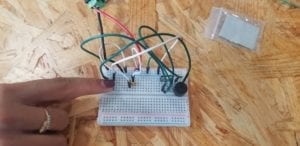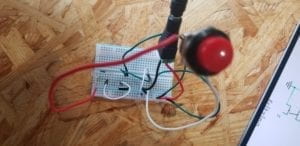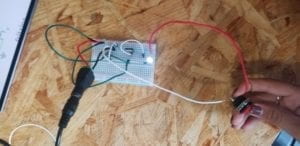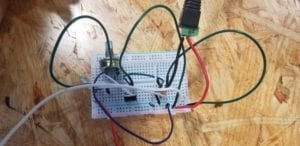During our recitation class, my partner and I were assigned to complete three different circuits in order to achieve three mechanisms: a doorbell, a lamp, and a dimmable lamp. Starting with the lamp, we attached the power source to a voltage regulator and a capacitor on the breadboard. The voltage regulator allowed us to receive the proper amount of voltage to power the speaker without harming it. The capacitor is used to stabilize the flow of electricity as it moves across the breadboard to the other components. We then connected a wire from the voltage regulator to the speaker, which is of course the mechanism that emits sound. The next step was to attach a switch, or in our case a button, to the speaker. This allows for us to physically control when electricity is received, completing the circuit and therefore emitting sound.

Here is our completed doorbell circuit.
For the lamp, we pretty much kept the same layout except for the addition of two components: a resistor and an LED. We connected the resistor to the voltage regulator, which allowed for us to further the control of electricity reaching the LED. The resistor was then connected to the LED, our source of light for our lamp. This is where we ran into some problems. While reassembling our circuit, we placed the switch button facing the wrong direction. This meant that the flow of electricity wasn’t properly reaching our desired destination and had to be switched.


Lastly, we built a dimmable lamp using one additional component placed between the resistor and LED, a variable resistor. This variable resistor simply allowed us to physically alter the flow of electricity reaching the LED and therefore dimming the light. Here, we were faced with perhaps the most challenging problem. After several attempts at refiguring the wires and other components, we could not get the LED to turn on. After receiving help from a TA, we found that we were given a faulty variable resistor, and once replaced, we were able to complete the task.

Question 1:
After the assigned reading, I found that all three of the circuits we built included interactivity in the sense that my participation in the action of touching the switch button resulted in the circuit reacting with a response. As the article defines interaction to be “a cyclic process in which two actors alternately listen, think, and speak”, the case can be made that my pressing of the button caused the computer to “listen” to my request and come up with a response, or metaphorically “speak”.
Question 2:
I feel that the goal of art is to reach the audience with an emotion or feeling. This same idea can be transmitted through Design and Physical computing as is shown in Zach Lieberman’s work. His technology allowed for a man who was paralyzed throughout his entire body to create graffiti art using just his eyes. This incredible feat amplified the emotional reflection felt by the audience, as it captured the spark of relief that this man’s passion was not lost due to his illness. Physical computing extends the capabilities for artists, hence allowing for more impactful and more interactive forms of art.